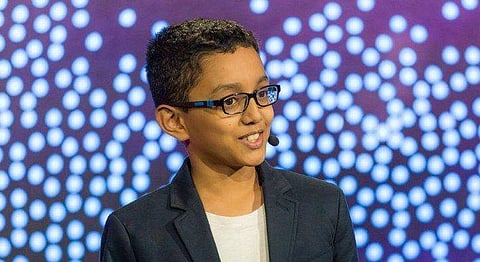

When we watch a viral video on how plastic waste is harming animals, both in the sea and on land, our first instinct is to feel sad and then, share the video on social media with a heartfelt message to save these animals. But when 12-year-old Haaziq Kazi watched an ocean waste documentary two years ago on National Geographic, he couldn't just sit back and feel sad. He felt he had to do something to prevent aquatic animals and birds from getting injured due to plastic waste that's often dumped in our seas and oceans. So, he did some reading to learn some important facts and figures regarding animals deaths due to plastic and then, designed a ship that can suck 100 tonnes of plastic waste from large water bodies. He named this ship ERVIS.
"Ocean pollution is a massive challenge and of enormous magnitude. Just to give you an idea, the amount of known waste floating on the surface, which is just a small percentage of the actual level of pollution, is approximately 5 trillion pieces of plastic. If we were to line up this plastic, do you know how far it would go? It would be enough to cover the distance from here to the Moon and back, twice! I have seen horrifying and heart-wrenching pictures and videos of animals that have starved to death because they ate the plastic and were unable to get it out of their stomach, or animals becoming tangled in it and getting badly hurt," he says. These reasons were enough to motivate him to clean up the water bodies.
Explaining the working mechanism of ERVIS to quench our curiosity, he says, "It is based on some basic physics concepts like centripetal force. The process involves a multi-stage cleaner that uses size-based separation to separate different sizes of waste and a compactor to crush it. There are saucers attached to ERVIS and they float on the surface, moving circularly to pull the waste towards the centre. They will have a central outlet that will swallow the waste and they are connected to various chambers in the ship. Once the waste enters the chambers, the process of segregation begins. The first level is an oil filter, which collects waste oil and sends it to the oil chamber. This waste oil will either be decomposed or stored for safe disposal. The second, third, fourth and fifth chambers are for large, medium, small and micro waste, respectively. The dimensions of ERVIS have been designed to be 40 metres long, 12 metres wide and 25 metres high, with a weight of around 600 tonnes."
But the process of cleaning does not end here. Once the waste passes through the chambers, it is sent to the segregator to separate plastic from non-plastic waste. The plastic is compacted and stored in cubes. The other waste is either degraded with bacteria or stored for separate disposal. The water that finally comes through will be cleaner and be pumped back into the ocean. But why only large water bodies, we wonder. "The device can be used in any water body and can be transformed for multiple form factors. It ideally works for deep water, but it can be modified such that the system can be placed in smaller boats to clean the rivers and lakes," he replies, seemingly prepared for that question.
Haaziq's current future plan is to see ERVIS become a reality in the future. "The magnitude of the problem represents a huge opportunity which needs to be addressed. I want to see ERVIS becoming a reality in the future and multiple ERVISes manning the oceans and cleaning our waste. I see myself tackling other ocean problems and researching more on ocean waste. Also, we can't forget about the waste on our beaches. I would like to identify ways and means to recycle this waste too," he concludes confidently.
